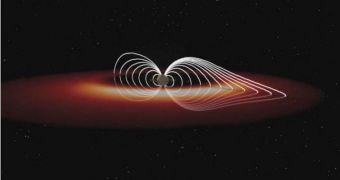Researchers at the Johns Hopkins University (JHU) Applied Physics Laboratory (APL) in Laurel, Maryland announce the discovery of a previously-unknown causal link between plasma explosions around Saturn and the periodic radio signals the gas giant's magnetic fields create.
The results were derived from thorough analyses of datasets obtained by the NASA Cassini orbiter, which has been surveying Saturn's atmosphere, rings and moons since July 1, 2004.
For year, astronomers have had a really difficult time trying to measure simple characteristics of the planet, such as how long its days are. This is due to the fact that massive plasma clouds tend to “bloom” periodically around the gas giant.
As this happens, the formations move around Saturn in a highly-imbalanced way, which reminds planetary scientists of loads of laundry during a washing machine's spin cycle.
The main effect this phenomenon has is the generation of a repeating signature “thump” in data about the planet's rotating magnetic environment.
“This is a breakthrough that may point us to the origin of the mysteriously changing periodicities that cloud the true rotation period of Saturn,” explains JHU APL researcher Pontus Brandt.
“The big question now is why these explosions occur periodically,” adds the expert, who is a Cassini team scientist. He is also the lead author of a new paper detailing the findings.
Another important conclusion of the investigation is the discovery of a highly-complex “choreography” that develops between electrical currents, magnetic fields and plasma injections around the gas giant.
According to the APL team, all the plasma explosions – which occur at regular intervals – cause islands of pressure as they rotate around Saturn, which in turn inflate the planet's magnetic field.
One characteristic things that sets the gas giant apart from other planets is the fact that it has a magnetotail, which is a structure formed as solar winds batter its magnetosphere with intensity.
As this happens, the entire defensive shield is deformed, and forced to “trail” the planet on the side opposite to the Sun.
“What's important about this new work is that scientists are beginning to describe the global, causal relationships between some of the complex, invisible forces that shape the Saturn environment,” explains expert Marcia Burton.
“The new results still don't give us the length of a Saturn day, but they do give us important clues to begin figuring it out,” adds the scientist, who is based at the NASA Jet Propulsion Laboratory (JPL), in Pasadena, California.
“The Saturn day length, or Saturn's rotation rate, is important for determining fundamental properties of Saturn, like the structure of its interior and the speed of its winds,” she goes on to say. Burton also holds an appointment as a Cassini fields and particles investigation scientist at JPL.

 14 DAY TRIAL //
14 DAY TRIAL //